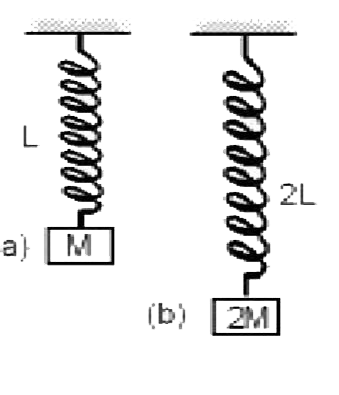A spring elongated by length L when a mass M is suspended to it. Now a tiny mass m is attached and then released its time period of oscillation is -
Correct Answer is: 1∵ T = 2π √M/K ∴ Mg = KlTherefore T = 2π √M + ml / Mg
Related Solutions
A spring elongated by length 'L' when a mass 'M' is suspended to it. Now a tiny mass 'm' is attached and then released, its time period of oscillation is -
View SolutionA spring elongated by length 'L' when a mass 'M' is suspended to it. Now a tiny mass 'm' is attached and then released, its time period of oscillation is -
View SolutionThe oscillation period of mass M suspended from a spring of negligible mass is T. If suspended too, now there will be oscillation period:
View SolutionTwo springs of the same material but of length L and 2L are suspended with masses M and 2M attached at their lower ends. Their time periods when they are allowed to oscillate will be in the ratio
 View Solution
View SolutionThe period of oscilation of a mass suspended a spring negligible mass is if along with it and there mass is also suspended the period of oscillation now be
View SolutionThe period of oscillation of a mass M suspended from a spring of negligible mass is T. If along with it another mass M is also suspended, the period of oscillation will now be :
View SolutionThe period of oscillation of a mass m suspended from a spring of negligible mass is T. If along with it another mass m is also suspended the period of oscillation will now be……..
View SolutionThe period of oscillation of a mass m suspended from a spring of negligible mass is T. If along with it another mass M is also suspended the period of oscillation will now be:
View SolutionThe period of oscillation of mass M suspended from a spring of negligible mass is T. If along with it another mass M is also suspended, the period of oscillation will now be
View SolutionThe period of oscillation of mass M suspended from a spring of negligible mass is T. If along with it another mass M is also suspended, the period of oscillation will now be
View SolutionWhen a mass is attached to a spring, its length is increased by 20 cm. It is now further lowered and releases. The time period is
View SolutionA spring is connected to a mass m suspended from it and its time period for vertical oscillation is T. The spring is now cut into two equal halves and the same mass is suspended from one of the halves. The period of vertical oscillation is
View SolutionA spring is connected to a mass m suspended from it and its time period for vertical oscillation is T. The spring is now cut into two equal halves and the same mass is suspended from one of the halves . The period of vertical oscillation is
View SolutionA spring is connected to a mass m suspended from it and its time period for vertical oscillation is T. spring is now cut into two equal halved and the same mass is suspended fron one of the havles. The period of vertical oscillation is :
View SolutionA spring is connected to a mass m suspended from it and its time period for vertical oscillation is T. spring is now cut into two equal halved and the same mass is suspended fron one of the havles. The period of vertical oscillation is :
View SolutionA spring is connected to a mass m suspended from it and its time period for vertical oscillation is T. spring is now cut into two equal halved and the same mass is suspended fron one of the havles. The period of vertical oscillation is :
View SolutionWhen a mass M is suspended from a spring, its period of oscillation is 2 second. If a mass 4 M is suspended from the same spring, then its period of oscillation will be
View SolutionA mass 'M' is suspended from a spring of negligible mass. The spring is pulled a little and then released. It execuutes S.H. oscillations of period T. When mass is increased by 'm', the period becomes (5)/(4) T, the ratio (m)/(M) is :
View SolutionA body of mass m is attached to the lower end of a spring whose upper end is fixed. The spring has negligible mass. When the mass m is slightly pulled down and released, it oscillates with a time period of 3s. When the mass m is increased by , the time period of oscillations becomes 5s. The value of m in kg is
View SolutionA body of mass m is attached to the lower end of a spring whose upper end is fixed. The spring has negligible mass. When the mass m is slightly pulled down and released, it oscillates with a time period of 3s. When the mass m is increased by , the time period of oscillations becomes 5s. The value of m in kg is
View Solution
